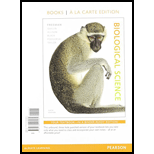
Concept explainers
Where does the citric acid cycle occur in eukaryotes?
a. in the cytosol of cells
b. in the intermembrane space of mitochondria
c. in the inner membrane of mitochondria
d. in the matrix of mitochondria
Introduction:
The citric acid cycle (CAC) or tricarboxylic acid cycle (TCA cycle) is a series of biochemical reactions, a stage of cellular respiration in cells that breakdowns the organic fuel molecules such as carbohydrates, proteins, and fats and releases energy through the oxidation of acetyl-CoA.
Answer to Problem 1TYK
Correct answer:
In the matrix of mitochondria
Explanation of Solution
Explanation/Justification for the correct answer:
Option (d) is given as mitochondrial matrix. Adenosine triphosphate (ATP) is classified as the source of energy in each cell in all the organisms. The conversion of glucose through a number of steps drives this energy conversion to ATP. One of the stages or a cycle is CAC. The space enclosed within the inner membrane of the mitochondria is called the matrix. The enzymes responsible for conducting the CAC are located in the matrix of the mitochondria. Hence, the Option (d) is correct.
Explanation for incorrect answers:
Option (a) is given as cell cytosol. The first stage of the breakdown of glucose is the glycolysis, where the end product is a 3-carbon compound called pyruvate. This reaction takes place in the cytosol in the eukaryotes. The space between the outer as well as the inner mitochondrial membranes and cristae make up the intermediate space, which contains no enzymes for these reactions. Hence, the option (a) is incorrect.
Option (b) is given as mitochondrial intermembrane space. The inner membrane of the mitochondria contains transporter proteins, which transfer the pyruvate to the mitochondrial matrix for further processing. Hence, the option (b) is incorrect.
Option (c) is given as mitochondrial inner membrane. Except glycolysis, all the enzymes for cellular respiration occur mostly in the mitochondrial matrix in the eukaryotes. Hence, the option (c) is incorrect.
The citric acid cycle (CAC) occurs in the matrix of mitochondria in eukaryotes.
Want to see more full solutions like this?
Chapter 9 Solutions
Biological Science, Books a la Carte Plus Mastering Biology with Pearson eText -- Access Card Package (6th Edition)
- Noggin mutation: The mouse, one of the phenotypic consequences of Noggin mutationis mispatterning of the spinal cord, in the posterior region of the mouse embryo, suchthat in the hindlimb region the more ventral fates are lost, and the dorsal Pax3 domain isexpanded. (this experiment is not in the lectures).a. Hypothesis for why: What would be your hypothesis for why the ventral fatesare lost and dorsal fates expanded? Include in your answer the words notochord,BMP, SHH and either (or both of) surface ectoderm or lateral plate mesodermarrow_forwardNot part of a graded assignment, from a past midtermarrow_forwardNot part of a graded assignment, from a past midtermarrow_forward
- please helparrow_forwardWhat does the heavy dark line along collecting duct tell us about water reabsorption in this individual at this time? What does the heavy dark line along collecting duct tell us about ADH secretion in this individual at this time?arrow_forwardBiology grade 10 study guidearrow_forward
 Human Biology (MindTap Course List)BiologyISBN:9781305112100Author:Cecie Starr, Beverly McMillanPublisher:Cengage Learning
Human Biology (MindTap Course List)BiologyISBN:9781305112100Author:Cecie Starr, Beverly McMillanPublisher:Cengage Learning Biology (MindTap Course List)BiologyISBN:9781337392938Author:Eldra Solomon, Charles Martin, Diana W. Martin, Linda R. BergPublisher:Cengage Learning
Biology (MindTap Course List)BiologyISBN:9781337392938Author:Eldra Solomon, Charles Martin, Diana W. Martin, Linda R. BergPublisher:Cengage Learning Human Physiology: From Cells to Systems (MindTap ...BiologyISBN:9781285866932Author:Lauralee SherwoodPublisher:Cengage Learning
Human Physiology: From Cells to Systems (MindTap ...BiologyISBN:9781285866932Author:Lauralee SherwoodPublisher:Cengage Learning Concepts of BiologyBiologyISBN:9781938168116Author:Samantha Fowler, Rebecca Roush, James WisePublisher:OpenStax College
Concepts of BiologyBiologyISBN:9781938168116Author:Samantha Fowler, Rebecca Roush, James WisePublisher:OpenStax College Human Heredity: Principles and Issues (MindTap Co...BiologyISBN:9781305251052Author:Michael CummingsPublisher:Cengage Learning
Human Heredity: Principles and Issues (MindTap Co...BiologyISBN:9781305251052Author:Michael CummingsPublisher:Cengage Learning Biology Today and Tomorrow without Physiology (Mi...BiologyISBN:9781305117396Author:Cecie Starr, Christine Evers, Lisa StarrPublisher:Cengage Learning
Biology Today and Tomorrow without Physiology (Mi...BiologyISBN:9781305117396Author:Cecie Starr, Christine Evers, Lisa StarrPublisher:Cengage Learning





